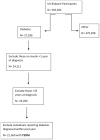Is Environmental and Occupational Particulate Air Pollution Exposure Related to Type-2 Diabetes and Dementia? A Cross-Sectional Analysis of the UK Biobank
- PMID: 33371391
- PMCID: PMC7767456
- DOI: 10.3390/ijerph17249581
Is Environmental and Occupational Particulate Air Pollution Exposure Related to Type-2 Diabetes and Dementia? A Cross-Sectional Analysis of the UK Biobank
Abstract
Human exposure to particulate air pollution (e.g., PM2.5) can lead to adverse health effects, with compelling evidence that it can increase morbidity and mortality from respiratory and cardiovascular disease. More recently, there has also been evidence that long-term environmental exposure to particulate air pollution is associated with type-2 diabetes mellitus (T2DM) and dementia. There are many occupations that may expose workers to airborne particles and that some exposures in the workplace are very similar to environmental particulate pollution. We conducted a cross-sectional analysis of the UK Biobank cohort to verify the association between environmental particulate air pollution (PM2.5) exposure and T2DM and dementia, and to investigate if occupational exposure to particulates that are similar to those found in environmental air pollution could increase the odds of developing these diseases. The UK Biobank dataset comprises of over 500,000 participants from all over the UK. Environmental exposure variables were used from the UK Biobank. To estimate occupational exposure both the UK Biobank's data and information from a job exposure matrix, specifically developed for UK Biobank (Airborne Chemical Exposure-Job Exposure Matrix (ACE JEM)), were used. The outcome measures were participants with T2DM and dementia. In appropriately adjusted models, environmental exposure to PM2.5 was associated with an odds ratio (OR) of 1.02 (95% CI 1.00 to 1.03) per unit exposure for developing T2DM, while PM2.5 was associated with an odds ratio of 1.06 (95% CI 0.96 to 1.16) per unit exposure for developing dementia. These environmental results align with existing findings in the published literature. Five occupational exposures (dust, fumes, diesel, mineral, and biological dust in the most recent job estimated with the ACE JEM) were investigated and the risks for most exposures for T2DM and for all the exposures for dementia were not significantly increased in the adjusted models. This was confirmed in a subgroup of participants where a full occupational history was available allowed an estimate of workplace exposures. However, when not adjusting for gender, some of the associations become significant, which suggests that there might be a bias between the occupational assessments for men and women. The results of the present study do not provide clear evidence of an association between occupational exposure to particulate matter and T2DM or dementia.
Keywords: ACE JEM; UK Biobank; air pollution; dementia; environmental exposure; epidemiological analysis; epidemiology; occupational exposure; particulate matter; type 2 diabetes.
Conflict of interest statement
The authors declare no conflict of interest.
Figures
Similar articles
-
Exposure to air pollution and risk of incident dementia in the UK Biobank.Environ Res. 2022 Jun;209:112895. doi: 10.1016/j.envres.2022.112895. Epub 2022 Feb 8. Environ Res. 2022. PMID: 35149105 Free PMC article.
-
Evaluation of the Suitability of an Existing Job-Exposure Matrix for the Assessment of Exposure of UK Biobank Participants to Dust, Fumes, and Diesel Exhaust Particulates.Int J Environ Res Public Health. 2020 Jul 8;17(14):4919. doi: 10.3390/ijerph17144919. Int J Environ Res Public Health. 2020. PMID: 32650426 Free PMC article.
-
Exposure to Environmental and Occupational Particulate Air Pollution as a Potential Contributor to Neurodegeneration and Diabetes: A Systematic Review of Epidemiological Research.Int J Environ Res Public Health. 2018 Aug 9;15(8):1704. doi: 10.3390/ijerph15081704. Int J Environ Res Public Health. 2018. PMID: 30096929 Free PMC article.
-
Risk analysis of air pollutants and types of anemia: a UK Biobank prospective cohort study.Int J Biometeorol. 2024 Jul;68(7):1343-1356. doi: 10.1007/s00484-024-02670-0. Epub 2024 Apr 12. Int J Biometeorol. 2024. PMID: 38607561
-
Association between Air Pollution and Type 2 Diabetes Mellitus in Developing Countries: A Systematic Review and Meta-Analysis.Chin Med Sci J. 2022 Sep 30;37(3):218-227. doi: 10.24920/004065. Chin Med Sci J. 2022. PMID: 36321177
Cited by
-
Midlife and late-life environmental exposures on dementia risk in the Wisconsin Longitudinal Study: The modifying effects of ApoE.Alzheimers Dement. 2024 Dec;20(12):8263-8278. doi: 10.1002/alz.14216. Epub 2024 Nov 22. Alzheimers Dement. 2024. PMID: 39576060 Free PMC article.
-
Ambient air pollution and clinical dementia: systematic review and meta-analysis.BMJ. 2023 Apr 5;381:e071620. doi: 10.1136/bmj-2022-071620. BMJ. 2023. PMID: 37019461 Free PMC article.
-
Ranking the risk factors for Alzheimer's disease; findings from the UK Biobank study.Aging Brain. 2023 Jun 17;3:100081. doi: 10.1016/j.nbas.2023.100081. eCollection 2023. Aging Brain. 2023. PMID: 37384134 Free PMC article.
-
Exposure to air pollution and risk of incident dementia in the UK Biobank.Environ Res. 2022 Jun;209:112895. doi: 10.1016/j.envres.2022.112895. Epub 2022 Feb 8. Environ Res. 2022. PMID: 35149105 Free PMC article.
-
Joint Exposure to Multiple Air Pollutants, Genetic Susceptibility, and Incident Dementia: A Prospective Analysis in the UK Biobank Cohort.Int J Public Health. 2024 Feb 15;69:1606868. doi: 10.3389/ijph.2024.1606868. eCollection 2024. Int J Public Health. 2024. PMID: 38426188 Free PMC article.
References
-
- Stone V., Miller M.R., Clift M.J.D., Elder A., Mills N.L., Moller P., Schins R.P.F., Vogel U., Kreyling W.G., Alstrup Jensen K., et al. Nanomaterials Versus Ambient Ultrafine Particles: An Opportunity to Exchange Toxicology Knowledge. Environ. Health Perspect. 2017;125:106002. doi: 10.1289/EHP424. - DOI - PMC - PubMed
-
- Jovanovic-Andersen Z. Health effects of long-term exposure to air pollution: An overview of major respiratory and cardiovascular diseases and diabetes. Chem. Ind. Chem. Eng. Q. 2012;18:617–622. doi: 10.2298/CICEQ120110112J. - DOI
-
- WHO . Air Pollution and Cancer. WHO; Geneva, Switzerland: 2013.
-
- Donaldson K., Stone V. Current hypotheses on the mechanisms of toxicity of ultrafine particles. Annali Dell’Istituto Superiore Di Sanita. 2003;39:405–410. - PubMed
Publication types
MeSH terms
Substances
LinkOut - more resources
Full Text Sources
Medical
Miscellaneous


